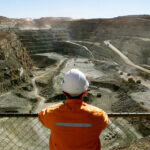Energy News Beat
Editor’s note: This story was originally published by Yale Environment 360. It appears here as part of the Climate Desk collaboration.
When the world convenes in the United Arab Emirates for the next round of the endless climate slog, much attention will be paid to the pledges of individual nations to cut their emissions. This has been the basic scorecard of climate talks almost since the start. But it’s a wildly incomplete scorecard, in ways that are becoming ever clearer as we enter the endgame of the energy transition. We’ve been measuring it wrong.
That’s because a country’s exports of fossil fuel don’t count against its total. But it’s those exports that are driving fossil fuel expansion around the world, coming as they do from some of the most diplomatically powerful and wealthy nations on Earth.
To give the most obvious, and largest, example: the United States is, fitfully, cutting back on its carbon emissions; its envoys will be able to report, honestly, that the Inflation Reduction Act should soon actually be trimming our domestic use of oil, gas, and coal, as we subsidize heat pumps and build out EV charging networks. But at the very same moment, the U.S. production of fossil fuels is booming. That means, of course, that much of that supply is headed overseas.
And the numbers are truly staggering. If the liquefied natural gas (LNG) buildout continues as planned, for instance, by 2030 U.S. LNG exports will be responsible for more greenhouse gases than every house, car, and factory in the European Union. The emissions, under the U.N. accounting system, will show up on the scorecards of the EU and the dozens of mostly Asian nations that will buy the gas. But if you could see them in the atmosphere, they would be red, white, and blue.
Exactly the same thing is true of a handful of other nations — in fact, some are even more grotesque in their hypocrisy, if not their impact. Norway has, arguably, done as good a job as any country on earth on moving past oil and gas; almost every new car in the country runs on electricity. But it’s planning one of the dozen biggest expansions in national oil and gas production, almost all of it for export. Canada and Australia fall into the same basket. Indeed, a remarkable new report from Oil Change International (OCI) found that those four countries (the U.S., Canada, Australia, and Norway), along with the U.K., account for just over half of the planned expansion in oil and gas between now and mid-century. In most cases the project licenses have already been granted, and unless officials intervene, the damage (enough carbon and methane to take us past the Paris climate targets) is locked in.
But this means that if other nations and the climate movement could figure out how to pressure these countries to turn the spigot to the right, we could staunch much of this flow of greenhouse gases into the air. If five countries account for half the expansion problem — and if those five countries are rich and have diversified economies that allow them freedom of choice about their futures — then some of the main targets are clear. All of them, remember, have made the right noises about the need for urgent climate action; they just haven’t been willing to face down their exporters.
Canada continues to approve and/or subsidize new pipelines and LNG export projects, while permitting new oil and gas fields, putting it on track to become the world’s second-largest producer of oil and gas. Australia, the world’s third-largest fossil fuel exporter, has given the green light to major new coal and gas projects. Norway, Europe’s largest oil and gas producer, has awarded 47 new licenses for oil and gas projects in the Norwegian Sea and is permitting expansion into the Barents Sea in the Arctic. And the current Conservative government in the U.K. has adopted a policy to “max out” fossil fuel development in the North Sea.
As for the U.S., the OCI report makes clear it plans by far the biggest expansion of its oil and gas industry — about a third of the global total. Basically, this is a result of the invention of fracking, which beginning in the early 2000s allowed the rapid expansion of oil and gas production. We literally have more of the stuff than we know what to do with — so we needed to find other people to sell it to.
That would have been largely impossible prior to 2015 — since the oil shocks of the 1970s, the U.S. had had a ban on crude oil exports. But in one the great historical ironies of all time, Congress, under great pressure from the fossil fuel industry, lifted that ban the very week that the world was in Paris wrapping up the global climate accords. A few of us were fighting (with our laptops, from Paris cafes) to keep the ban in place; I coauthored an op-ed then that criticized congressional leaders as “politicians who simply don’t understand the physics of climate change.”
As it turns out, I didn’t understand the true scale of the disaster unfolding. Because it wasn’t just crude oil that was going to be sold abroad; until 2016 the U.S. had been a net importer of natural gas, but that year things began to turn. And it’s LNG that has truly turned America into an export monster. Enormous terminals — seven of them — have been built, mostly along the Gulf Coast, with 24 more planned; their business rationale is simply to take the excess gas produced by the fracking spree and send it overseas. And the numbers are astonishing. Remember the anger that President Biden brought upon himself (and the damage with young voters) when he stupidly approved the Willow oil complex in Alaska in March? Well, the next export terminal up for approval — CP2, in Cameron Parish, Louisiana — would be associated with 20 times the greenhouse gas emissions of the Willow project.
The Obama administration, of course, loved fracking — it seemed like an easy way out of both the climate and economic predicaments it inherited, jumpstarting the economy with cheap fossil fuel and, since natural gas produces less carbon than coal when its burned, allowing America’s CO2 emissions to fall. But on closer examination, it was a devil’s bargain: methane leaking from the natural gas production chain balanced out those carbon gains, and so it was unclear if total U.S. greenhouse gas emissions had even budged. But that didn’t slow the push for more — which accelerated after the Russian invasion of Ukraine, when the fossil fuel industry grabbed at the chance to expand natural gas production as an altruistic response. Whatever you think of that argument, we’ve already more than met the needs of the EU; it had enough gas for last winter, and more to come this year. There is definitely no need to build new terminals, which would lock in huge increases in production for the next 40 years.
That’s especially true since the old argument for exporting gas — it was cleaner than the coal being burned in Asia — no longer makes sense. Since sun and wind now produce the cheapest energy on earth, we’re no longer talking about transition fuels. The whole point of net zero emissions is that we have to move fast to the actually clean stuff.
And it’s especially true because we’ve been learning that exporting this stuff is even more dangerous than using it at home. A new paper from Cornell’s Bob Howarth (the dean of methane science) that I first reported on in the New Yorker last week has truly shocking implications. It showed that when you put LNG on a boat and send it off around the world, large amounts leak out in the process. In the best-case scenario, it is 24 percent worse for the climate than burning coal; in the worst case (old ship, long voyage) it’s 274 percent worse. This is mind-boggling and soul-sickening, and it makes the calculations in, say, the OCI report much more ominous.
Yet Biden could limit the damage. Though his administration has already approved too many of these projects, he could stop the ones that remain. Under federal law, the Department of Energy needs to grant an export license for each new terminal, certifying that sending it to countries with which we don’t have a free trade agreement is in the national interest. And clearly this isn’t; standing up here could help him regain some of the ground he lost with the Willow calamity. And it would be hard for the other side to demagogue. Because exporting natural gas clearly drives the price up here at home — that’s how economics works. Indeed, Biden could even reinstate the ban on crude oil exports lifted in 2015.
The most important decision any of these leaders — in the U.S., Canada, Australia, Norway, or the U.K. — could make is simply to say, “We won’t be the hydrocarbon equivalent of the narcotics cartels.” If they did, some of the slack would be taken up by other nations, like the United Arab Emirates, erstwhile host of the upcoming COP. But some of it would also be taken up by the switch to renewables; with the biggest suppliers leaving the market, prices would rise, and the spreadsheet would change. Again, that’s how economics works.
But the real question here may be, how do politics work? The fossil fuel industry demonstrated its firm grip on power in the U.S. in 2015 when it got the export ban lifted. Now the industry is flush with cash: Exxon reported a quarterly profit of $9.1 billion last month. It’s using its cash to buy up even more fracking real estate; clearly it concludes it has the political juice to enable it to face Biden down and keep on pumping gas for the planet.
And Exxon and the U.S. are not alone in this arrogance. In Canada, for instance, Prime Minister Justin Trudeau keeps talking a good game on reducing emissions — but at some level, who cares? There aren’t enough Canadians to produce that much carbon (indeed, the wildfires across the nation will produce more than twice as much as the people this year). Canada’s huge contribution to our global crisis is its exports. Trudeau quite honestly summed up his nation’s position in 2017 in a talk to Texas oilmen, when he told the truth about the country’s vast tar sands complex: “No country would find 173 billion barrels of oil in the ground and just leave them there.” Canada couldn’t burn 173 billion barrels of oil if everyone in the country kept their car idling 24 hours a day, and they couldn’t burn the enormous quantity of natural gas that’s been found further north in Alberta if they all turned their thermostats to 115 and wore bathing suits all winter. That’s why they’re busy building pipelines to take the oil and the gas to the Pacific.
I could do the same math for Australia or the U.K. or Norway. No matter what they stand up and say in the UAE over the next month, remember: They’ve decided to hold a fire sale at the end of the world.
ENB Top News
ENB
Energy Dashboard
ENB Podcast
ENB Substack
The post How wealthy countries evade responsibility for their fossil fuel exports appeared first on Energy News Beat.








